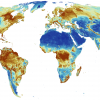Jung, M., Arnell, A., de Lamo, X., García-Rangel, S., Lewis, M. , Mark, J., Merow, C., Miles, L., Ondo, I., Pironon, S., Ravilious, C., Rivers, M., Shchepashchenko, D. , Tallowin, O., van Soesbergen, A., Govaerts, R., Boyle, B.L., Enquist, B.J., Feng, X., Gallagher, R., Maitner, B., Meiri, S., Mulligan, M., Ofer, G., Roll, U., Hanson, J.O., Jetz, W., Di Marco, M., McGowan, J., Rinnan, D.S., Sachs, J.D., Lesiv, M. , Adams, V.M., Andrew, S.C., Burger, J.R., Hannah, L., Marquet, P.A., McCarthy, J.K., Morueta-Holme, N., Newman, E.A., Park, D.S., Roehrdanz, P.R., Svenning, J.-C., Violle, C., Wieringa, J.J., Wynne, G., Fritz, S. , Strassburg, B.B. ., Obersteiner, M. , Kapos, V., Burgess, N., Schmidt-Traub, G., & Visconti, P. (2021). Areas of global importance for conserving terrestrial biodiversity, carbon and water. Nature Ecology & Evolution 5 1499-1509. 10.1038/s41559-021-01528-7.



